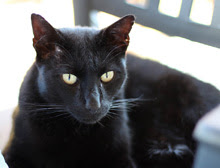Just outside of Le Puy-en-Velay, atop another volcanic butte, is the medieval fortress of Polignac. Construction began on the
château fort in the eleventh century. By the seventeenth century it had been abandoned, then used as a quarry for stone to build the neighboring towns.
The forteresse de Polignac seen from a hillside in Le Puy-en-Velay.
In the early nineteenth century, a descendant of the family that once owned the castle bought it back and began a restoration. Since then, archeological research and further restoration has taken place and the castle and fortress have become a popular tourist attraction.
Looking toward the west side of the fortress on its butte.
Because we visited in March, the place was closed for the winter. I doubt that we could have taken Tasha inside even if the castle was open, so it didn't matter much to us. I took two of these photos from just below the castle, on opposite sides. The shot with the rainbow, such as it is, is a long zoom taken from much farther away in Puy-en-Velay.
Looking up toward the donjon, or keep, on the east flank of the butte.
A funny thing happened last evening when I took the dog out. Our cat Bert was holding court in the back yard. He and three other cats were lounging in the grass near the vegetable garden. When I got outside, I noticed one cat scoot behind a hedge, but the other three just sat and watched us. There was another black cat and an orange cat. When I called Bert's name (from a distance, I couldn't tell which of the two black cats was him), he got up and started to walk over to me. The other cats stayed put, content to watch. Tasha and I left them in peace and went back into the house.


















































